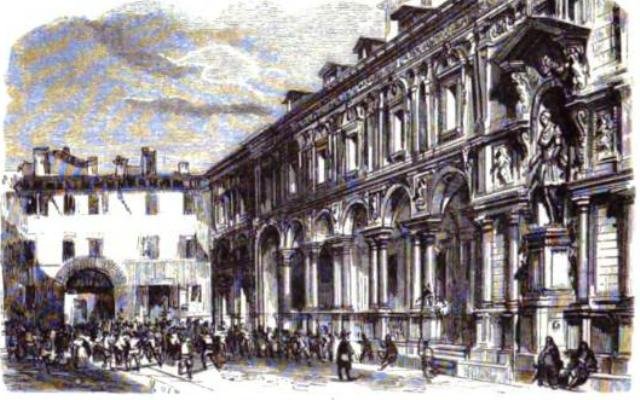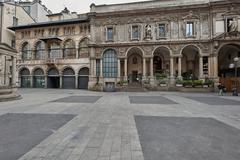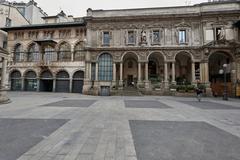
Visiting Palazzo delle Scuole Palatine, Milan: Tickets, Hours, and Attractions
Date: 14/06/2025
Introduction
Located in the heart of Milan’s historic Piazza Mercanti, the Palazzo delle Scuole Palatine stands as a testament to the city’s rich educational, cultural, and architectural heritage. Originally established as a prestigious center for advanced learning during the Middle Ages, it has played a pivotal role in shaping Milan’s intellectual and civic landscape. Today, the palace invites visitors to explore its storied past, appreciate its Baroque architecture, and discover its place among Milan’s most important historical sites. This comprehensive guide provides detailed information on the history, visiting hours, tickets, accessibility, guided tours, and nearby attractions, ensuring an enriching experience for all travelers (YesMilano; Mediolan.pl).
Table of Contents
Historical Overview
Origins and Early History
The roots of the Palazzo delle Scuole Palatine trace back to the 9th century, modeled after the Palatine schools of Charlemagne’s court. As Milan rose to prominence in northern Italy, the Scuole Palatine became the city’s primary institution for advanced studies in liberal arts, philosophy, and law. The school quickly garnered prestige, drawing notable scholars such as the poet Francesco Petrarca (Petrarch) and philosopher Cesare Beccaria (YesMilano).
Throughout the Middle Ages and Renaissance, the school played an essential role in Milan’s civic and cultural development, serving both the children of nobility and promising students from diverse backgrounds.
Architectural Significance
The present structure was rebuilt in 1644 by architect Carlo Buzzi following a devastating fire. Buzzi’s design reflects the transition from Renaissance to Baroque style, with a harmonious façade featuring classical motifs, a central balcony, and elegant pilasters. Noteworthy are the statues of Saint Augustine and the Roman poet Ausonius, which symbolize Milan’s enduring dedication to knowledge and intellectual achievement (Lombardia Beni Culturali; Milanodavedere.it).
Notable Events and Figures
Beyond its architectural prominence, the Palazzo hosted formative moments in Milanese education and culture. During Spanish and Austrian rule, the building adapted to changing academic demands, while in the Enlightenment, figures like Cesare Beccaria contributed to Milan’s reputation as a center for progressive thought and reform (YesMilano).
Role in Milanese Culture
The Palazzo delle Scuole Palatine, alongside neighboring civic buildings like Palazzo della Ragione and Loggia degli Osii, anchors Piazza Mercanti as the historic heart of Milanese society. Over centuries, the palace hosted public lectures, literary gatherings, and ceremonies, fostering a culture of scholarship and civic engagement (WeDreamOfTravel).
Restoration and Preservation
Following World War II, restoration projects were undertaken to repair war damage and preserve the palace’s Baroque façade and interiors. Today, the building is protected as a cultural heritage site, maintained by local authorities and heritage organizations (Lombardia Beni Culturali).
Visiting Information
Visiting Hours
- Exterior Viewing: The Palazzo delle Scuole Palatine’s façade and Piazza Mercanti are outdoor sites accessible at any time.
- Interior Access: The interior is not generally open to the public but may be accessible during special events or guided tours. Always check the official Milan tourism website or Mediolan.pl for up-to-date information.
Tickets and Admission
- Exterior & Piazza: Free, open access at all times.
- Special Events/Guided Tours: Some events or tours may require a ticket; prices and availability are announced via local cultural organizations and tourism offices. Advance reservation is recommended during peak seasons.
Accessibility
- Piazza Mercanti: Fully pedestrianized and accessible to visitors with mobility challenges.
- Interior: Accessibility may be limited; inquire with event organizers or the local tourist office before your visit.
Guided Tours and Special Events
Guided walking tours of Milan’s historic center often include the Palazzo delle Scuole Palatine and provide insights into its history and architecture. Special educational or cultural events are scheduled periodically; check local cultural calendars or the official Milan tourism website.
How to Get There
- Metro: Duomo (Lines 1 and 3) is the nearest station, a short walk from Piazza Mercanti.
- Tram/Bus: Multiple lines serve the area; consult the city’s public transportation site for details.
- On Foot: The site is just steps from the Duomo and Galleria Vittorio Emanuele II, ideal for exploring on foot.
Nearby Attractions
- Palazzo della Ragione
- Loggia degli Osii
- Milan Cathedral (Duomo di Milano)
- Galleria Vittorio Emanuele II
- Museo del Novecento
- Pinacoteca Ambrosiana
- Basilica of Sant’Ambrogio All are within easy walking distance and provide a comprehensive view of Milan’s historical, cultural, and artistic heritage.
Visuals and Media
- Exterior Photos: Capture the Baroque façade, statues, and decorative motifs.
- Alt Text Suggestions: “Palazzo delle Scuole Palatine Milan facade,” “historic Piazza Mercanti Milan,” “Baroque architecture Milan.”
- Virtual Tours: Available on official tourism platforms for remote exploration.
Frequently Asked Questions (FAQ)
Q: Is there an entry fee to visit the Palazzo delle Scuole Palatine?
A: No, viewing the exterior and Piazza Mercanti is always free. Special events or guided tours may have a fee.
Q: What are the visiting hours?
A: The exterior is accessible 24/7. The interior is only open during special events.
Q: Is the site wheelchair accessible?
A: The square is accessible; interior access may be limited.
Q: Are guided tours available?
A: Yes, many walking tours include the Palazzo; check with local tour providers.
Q: What else can I see nearby?
A: Palazzo della Ragione, Loggia degli Osii, Duomo di Milano, and other major historical sites are just steps away.
Conclusion
The Palazzo delle Scuole Palatine is a cornerstone of Milan’s historical and educational legacy. Its grand façade, symbolic sculptures, and location in the vibrant Piazza Mercanti make it a must-see for visitors eager to experience Milan’s medieval and Baroque spirit. With no admission fee for the exterior and proximity to other significant landmarks, it is an accessible and enriching stop on any Milan itinerary. Enhance your visit with guided tours or cultural events, and be sure to check the latest updates on official tourism channels for a seamless experience.
For more cultural insights and guided audio experiences, download the Audiala app and follow our channels for regular updates on Milan’s historical sites.





























































